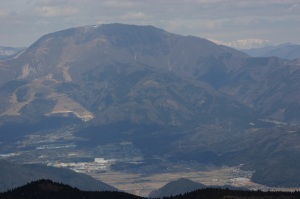Now that the 100 mountains are behind me, I can turn my attention to lesser-known peaks a little closer to home before the summer climbing season kicks in. I’d heard of Ryouzen from a few Kansai hikers, and had stared at it twice during my 2 ascents of neighboring Mt. Ibuki, so I took advantage of the low pollen counts on a Sunday in late March to investigate.

As the train rolled into Samegai station, I noticed the white tinge on the horizon. “Looks like winter has returned,” wondering if I would need my crampons that I’d conveniently left at home. I strolled up the paved road towards the trout farm, turning at all of the signposts before entering a cedar forest. I quickly slipped on the protective eye wear and face mask, lest any pollen fall from the trees overhead. You see, I’m severely allergic to cedar pollen and wanted to concentrate on the hike ahead instead of emptying the contents of my sinus cavity.

The trail ran straight through a dry, rocky riverbed for the first half an hour or so, before meeting up with a true mountain stream. I’d printed a map off the internet, which wasn’t very detailed, but I used my good sense of direction and kanji skills to guide me. I’ve done enough hiking in Japan to realize that most trails will run parallel to mountain streams until finding a gully gentle enough to ascend.

Up through the tranquil valley I rose, without meeting another single soul. I reached Urushi waterfall, climbing up the the base to take in the scenery. Breathtaking.

The snow got deeper on the sheltered north ridge, but the warm temperatures soon turned the path into a sloppy, muddy mess. Someone had tied ropes into the hillside, saving me from sliding down the steep valley below. The dale became rockier and steeper, but the higher elevation meant less mud and more ice. I soon stumbled across a frozen deer carcass, who must’ve fallen from the ridge high above me. The power of the elements.

A little after 11am, I popped out on the ridgeline, where the virgin foliage quickly gave way to bamboo grass. The views opened up, revealing Mt. Ibuki’s edifice rising grandly across the valley. Ondake and Norikura looked on from a safe distance. Although 300m lower than it’s more famous neighbor to the north, Ryouzen has been spared the shocking level of development that has plagued Mt. Ibuki. Everything has been pretty much untouched, sans a small emergency hut tucked away just out of sight. The wide, muddy path suggests that it has become a mecca for Kansai hikers disillusioned with the defacing of Mt. Ibuki. Indeed, once on the ridgeline, I converged with groups of climbers who’d approached from all directions. Dozens upon dozens of spectators, most of whom complained about the frigid winds. I can only imagine how the crowds must grow 10 fold when the alpine flowers are actually in bloom!
I promised myself to return during the harsh winter months, where I’d most likely have the place to myself. After all, that’s the true purpose of a reconnaissance mission in my book – scope out a peak worthy of a visit out of season. See you next January mighty Ryouzen.







Leave a comment